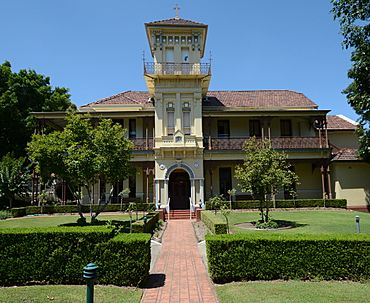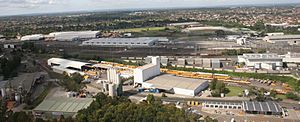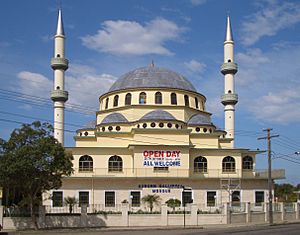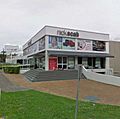Auburn, New South Wales facts for kids
Quick facts for kids AuburnNew South Wales |
|||||||||||||||
|---|---|---|---|---|---|---|---|---|---|---|---|---|---|---|---|

Duncraggarn Hall, a house now part of St Joseph's retirement village
|
|||||||||||||||
| Population | 39,333 (2021 census) | ||||||||||||||
| Established | 1793 | ||||||||||||||
| Postcode(s) | 2144 | ||||||||||||||
| Elevation | 23 m (75 ft) | ||||||||||||||
| Location | 16 km (10 mi) west of Sydney CBD | ||||||||||||||
| LGA(s) | Cumberland City Council | ||||||||||||||
| State electorate(s) | Auburn | ||||||||||||||
| Federal Division(s) | |||||||||||||||
|
|||||||||||||||
Auburn is a lively suburb in Western Sydney, New South Wales, Australia. It's about 16 kilometers (10 miles) west of the Sydney central business district (the city center). Auburn is part of the Cumberland City Council area.
The suburb got its name from a famous poem by Oliver Goldsmith called The Deserted Village. This poem describes a beautiful English village named 'Auburn' as the "loveliest village of the plain."
Contents
- History of Auburn
- People of Auburn (Demographics)
- Getting Around (Transport)
- Historic Places (Heritage Listings)
- Shopping and Business (Commercial Area)
- Important Places (Landmarks)
- Local News (Media)
- Schools in Auburn
- Places of Worship (Religious Structures)
- Famous People from Auburn (Notable People)
- Auburn in Pop Culture
- Images for kids
History of Auburn
Early Aboriginal History
Long ago, the Auburn area was an important meeting place for Aboriginal people. They used it as a market to trade goods. It was also a special "Law Place" for ceremonies and sometimes for ritual battles. This area was where the Darug people from inland met the Eora/Dharawal people from the coast.
The Wangal and Wategoro groups are often recognized as the first people living in the Auburn and Homebush Bay region. Famous Aboriginal leaders like Bennelong and Pemulwuy were part of the Wangal group. Pemulwuy led resistance against the early European settlers.
European Exploration and Naming
Soon after Captain Arthur Phillip arrived in Sydney Cove in 1788, explorers like Captain John Hunter and Lieutenant William Bradley sailed up the Parramatta River. They reached Homebush Bay, becoming the first Europeans in the Auburn area.
A few days later, Governor Phillip explored inland. His party discovered a river that seemed to have many ducks. They named it Duck River. The "ducks" were actually Eastern Swamp Hens, but the name stuck. This bird was even on the former Auburn City Council logo.
First Free Settlers in Auburn
In February 1793, Auburn became the first place in Australia for free farmers to settle. Governor Phillip wanted free settlers to help the colony grow. The British government agreed and sent several farmers, including some Quakers.
The first land grants were given to Thomas Rose, Frederic Meredith, Thomas and Joseph Webb, and Edward Powell. Their farms were called Liberty Plains. The settlers were very proud to be the first free people to choose their own land in the colony. This pride is shown in the motto on the Auburn coat of arms: "Liberty, with steady zeal."
How Auburn Got Its Name
In the late 1870s, a new "township" was planned in the middle of Liberty Plains. It was about 11 miles from Sydney, along the railway line. This new area was named 'Auburn'.
Advertisements for land sales in 1878 quoted Goldsmith's poem, saying: "Sweet Auburn! Loveliest village of the plain." They added that this description fit the "new Auburn of the Sunny South" perfectly.
One of the early settlers was Fred Chisholm. Later, in the 1880s, a timber merchant named John Buchanan built a large house called 'Duncraggarn Hall'. In 1892, the Sisters of Charity bought the house. They turned it into St Joseph's Hospital. Over time, it became St Joseph's Village, a retirement village. 'Duncraggarn Hall' is now a heritage-listed building.
Auburn Council and Modern Times
The official Auburn Local Government Area was created in 1948. This happened when the Auburn and Lidcombe Councils joined together. In 2006, it became the City of Auburn. However, in 2016, the area was divided and became part of other local government areas.
In recent times, Auburn has become a popular home for many immigrants. After World War II, people from Ukraine, Russia, Italy, and Greece settled here. Later, in the 1960s, immigrants from Turkey and Vietnam arrived. More recently, people from China, South Korea, Nepal, Iran, and Afghanistan have made Auburn their home. This rich history of immigration has made Auburn a very multicultural place.
People of Auburn (Demographics)
The 2021 census showed that 39,333 people live in Auburn. Many different backgrounds make up the community. The most common ancestries are Chinese, Nepalese, Turkish, Lebanese, and Indian.
About 28% of people were born in Australia. Other common birthplaces include China, Nepal, India, Turkey, and Pakistan. While 12.2% of people speak only English at home, many other languages are spoken. These include Mandarin, Nepali, Arabic, Turkish, and Urdu.
Auburn is also home to people of many faiths. The most common religions are Islam, No Religion, Hinduism, and Catholicism.
Getting Around (Transport)
Trains
Auburn railway station is a busy hub. It's on the Western and Leppington & Inner West lines of the Sydney Trains network. Trains run very often from here.
Near Auburn, there's a large facility called the Auburn Maintenance Centre. This is where Sydney Trains keep and fix their trains.
Buses
Auburn also has many bus services that connect it to nearby areas.
Busways operates two routes from Auburn station:
- 540: to Silverwater Correctional Complex
- 544: to Macquarie Centre
Transit Systems operates four routes through Auburn station:
- 908: Merrylands to Bankstown
- 909: Parramatta to Bankstown
- 911: to Bankstown
- S3: to Auburn Botanical Gardens
Auburn railway station is also served by two NightRide bus routes, which run late at night:
- N60: Fairfield station to Town Hall station
- N61: Carlingford station to Town Hall station
Historic Places (Heritage Listings)
Auburn has several places that are protected because of their history. These include:
- Great Southern and Western railway: Auburn Railway Signal Box
- 93 Parramatta Road: Electricity Substation No. 167
Shopping and Business (Commercial Area)
Auburn has a mix of homes, shops, and factories. The main shopping area is near Auburn railway station. You'll find many different restaurants and cafes there.
South of the station, the shopping area stretches for about 1 kilometer (0.6 miles). It has many shops, restaurants, and supermarkets. Many of these specialize in products and food from the Middle Eastern, Turkish, and East Asian cultures. This shows how many different immigrant groups have settled in Auburn.
North of the town center, along Parramatta Road, there are more shops and industrial businesses.
Auburn is also home to the Auburn Wildcats, a team in the LFL (Legends Football League). They play in the Australian Eastern Conference.
Important Places (Landmarks)
- Auburn Hospital has basic 24-hour emergency services. It's on Norval and Hargrave Streets.
- Auburn Botanical Gardens is a beautiful park.
Local News (Media)
- The Auburn News and Granville Electorate Gazetteer was a local newspaper published from 1903 to 1907.
Schools in Auburn
- Al-Faisal College
- Alpha Omega Senior College
- Auburn Girls High School
- Auburn North Public School
- Auburn West Public School
- Auburn Public School
- Amity College (Auburn Campus)
- St John of God Primary school
- St Joseph The Worker Primary School
- Trinity Catholic College
- Sydney Adventist College, Auburn Campus
Places of Worship (Religious Structures)
The Auburn Baptist Church first opened in 1888. Since 1928, it has been at its current location on Harrow Road.
The Sri Mandir in Auburn is Australia's oldest Hindu temple. It opened in 1977.
The Auburn Gallipoli Mosque took 13 years to build. It was mostly paid for by the Turkish community in the area. The mosque's name honors Gallipoli in Turkey. It also shows the strong connection between Australian society and the Australian Turkish Muslim Community who built it.
Famous People from Auburn (Notable People)
- Chris Bath, a television and radio journalist.
- John Benaud, an Australian test cricketer.
- Hippolyte De La Rue, a Senior RAAF Commander.
- Ahmad Elrich, a football (soccer) player.
- Tarek Elrich, a football (soccer) player.
- Brad Fittler, a former professional rugby league player and coach, born in Auburn.
- Alex Gersbach, a football (soccer) player.
- Jamal Idris, a rugby league player.
- Scott Jamieson, a football (soccer) player.
- Tomi Juric, a football (soccer) player.
- Jack Lang, a former Premier of NSW (1925–1927, 1930–1932). He had strong ties to Auburn, where he ran a successful real estate business and served as Mayor.
- Feleti Mateo, a rugby league player.
- Grant Millington, a rugby league player.
- John Moulton, a general surgeon in Auburn.
- Warren Mundine, the first Indigenous president of the Australian Labor Party. He lived in Auburn in the mid-1960s.
- Lelea Paea, a rugby league and rugby union player.
- Lopini Paea, a rugby league player.
- Mickey Paea, a rugby league player.
- Stanley Llewellyn Perry, a Lieutenant-Colonel in World War I.
- Garry Rush, a racing driver.
- Zeb Taia, a rugby league player.
- Kelepi Tanginoa, a rugby league player.
- Tevita Tatola, a rugby league player with South Sydney Rabbitohs.
- Anthony Watmough, a rugby league player.
Auburn in Pop Culture
- The SBS television drama East West 101 was filmed in Auburn.
Images for kids









